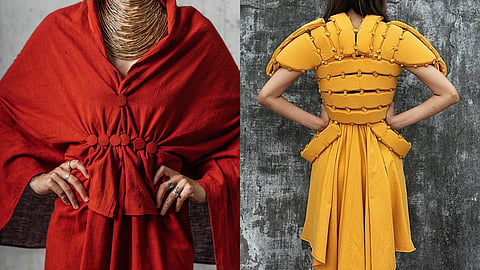
- HOMEGROWN WORLD
- #HGCREATORS
- #HGEXPLORE
- #HGVOICES
- #HGSHOP
- CAREERS
- ABOUT US
- CONTACT US

An approach to fashion that doesn’t require cutting or sewing and is one size fits all - the concept might seem far-fetched. But the reality is that clothes started simply as swathes of fabric draped and folded over, reused and repurposed. Over the years, scissors, seams and stitches entered the sartorial world, and the rest is history. While the fashion world has moved aeons ahead and become a part of our cultural tapestry, a million shortcuts and innovations made in its name have also resulted in making major impact on the world - from economy to environment.
However, there are up-and-coming fashion innovators who have delved into history, looked at the prevailing problems from a solution-oriented lens and created truly novel and sustainable processes to revolutionise how the fashion industry impacts the world. Anuj Sharma is a designer and fashion industry expert who created a Joinery technique that involves no cutting, sewing, or stitching - eliminating major instances where wastage may arise and essentially extending the life period of textiles. Using the Button Masala technique, the designer has created everything from dresses and tunics to statement accessories.
Anuj Sharma is a fashion designer hailing from Ahmedabad, who started his fashion journey at the National Institute of Design (NID), and went on to make his mark on the fashion scene with his debut collection titled Sunday Market, in 2007. However, it was in 2009 that he introduced the world to Button Masala, the aforementioned method that challenges the very foundation of modern fashion design via conventional stitching and sewing.
The genesis of Button Masala lay in Anuj's desire for a quick and easy garment-making process. Observing a man on the street wearing a shirt with buttons in the wrong loops sparked an idea:
What if buttons and a simple grid system could offer endless possibilities for wearing an outfit?
This thought led to the birth of Button Masala in 2009, the technique in which Anuj started with using buttons and rubber bands to hold two pieces of fabric together.
The simplicity of using buttons and rubber bands is what makes it a quick, cost-effective, and environmentally friendly way to create garments. The technique is not limited to clothing; it extends to creating carpets, bags, jewellery, shoes, and various other products. Each item can be easily recycled and restructured by rearranging the buttons, making it one of the greenest construction methods in the world.
As Anuj explained in his interview with another publication, "It’s the fastest way to make a garment. Takes me three minutes on average." The method involves strategically placing buttons and using rubber bands to secure the fabric, eliminating the need for scissors, machines, or traditional stitching. The result is a garment or design object that can be worn in multiple ways, offering a sustainable alternative to traditional fashion, which he in no way wants to gate-keep for himself. His philosophy with Button Masala is clear: no technique should be exclusive, and education is the key to widespread adoption.
In dedicating most of his time to sharing his knowledge, Anuj Sharma holds on to his vision - to empower individuals and the garment industry. He conducts virtual workshops, teaching people how to create fuss-free garments without sewing. 'The Button Up With Anuj Sharma' workshop is an hour-long online session where participants not only learn the technique but also delve into the philosophy behind the brand. Sharma's approach is inclusive, welcoming both kids and adults who want to explore their creative side without the need for expensive tools or machinery. In many of his earlier interviews, Anuj also talks about how he doesn’t take himself too seriously and loves to teach the Button Masala technique to everyone from 9 to 90.
There are many designers homegrown and global, who’ve learned the Button Masala technique from Anuj and made it their own, such as Ecole des Arts Decoratifs graduate Ghislain Paciorkowski, who is now applying aspects of the Button Masala technique to his couture pieces that he is designing in Paris. In an era where fast fashion dominates, Anuj Sharma's Button Masala stands as a beacon of sustainability and creativity. His approach challenges the norms of the fashion industry, encouraging individuals to rethink their relationship with clothing.
With each button and rubber band, Anuj Sharma’s Button Masala is crafting a new narrative of innovation, empowerment, and greener practices within the industry of fashion, through education; not just business.
You can follow them here.
If you liked reading this, here's more from Homegrown:
Indian Designer Alan Kaleekal Tells Us What It Takes To Build A Truly Sustainable Label
How A Goa-Based Circular Fashion Label Makes Bags Out Of Discarded Aircraft Materials
From Roots to Runway: 4 Homegrown Brands Pioneering Sustainable & Gender-Fluid Fashion
